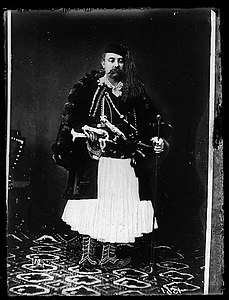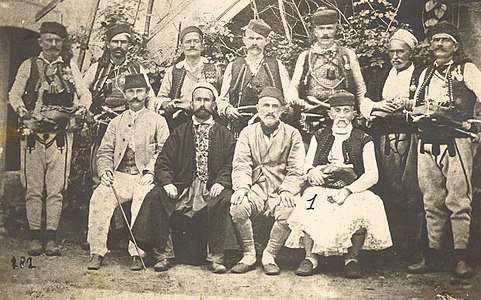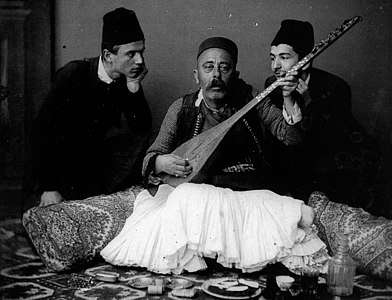Pietro Marubi
Pietro Marubi (Albanian: Pjetër Marubi; 1834 – 1903) was an Italian painter, sculptor, architect and photographer and founder of the Marubi studio who spent most of his life in Sanjak of Shkodër, today Albania.[1] Pietro was born in Piacenza, Italy in 1834, in a period of revolution for Europe. In 1856, Marubi was forced to leave Italy because of his participation in the Garibaldi movement, he moved to Shkodër, where he opened the first photography studio, which was named Dritëshkronja.[2][3][4]
Pietro Marubi | |
|---|---|
.jpg) Photograph of Marubi shortly before his death | |
| Born | Pietro Marubbi 1834 Piacenza, Duchy of Parma (now Italy) |
| Died | 1903 (aged 68–69) Shkodër, Vilayet of Scutari, Ottoman Empire |
| Known for | Photography |
Biography
Early life
Pietro Marubi was born in 1834 in the city of Piacenza, then part of the Duchy of Parma. In young age, he was fascinated and involved in the political and social movement that consolidated different states of the Italian peninsula into the single unitary state. As such, he was considered supporter of Garibaldis expedition against Austro-Hungarians. In 1856, he was forced to leave his native country after being accused of involvement in the murder of the mayor of Piacenza. Trying to get asylum in the Ottoman Empire, he heads to Corfu, from where he leaves to reach Vlorë, but without taking asylum.[5] Shortly after staying in this city, he decided to move to Shkodër, populated by Catholics and a small community of Italians in the city.[6]
Early career
In Shkodra, he decided to dedicate himself to his passion for photography, and so decided to open a photographic studio that he named "Dritëshkronja" (meaning Written with the light). His name also changed, thus becoming Pjetër Marubi, which is the Albanian equivalent of the name Pietro.[7] During the first months of staying he met Arsen Idromeno, with whom he became a family friend. Kolë Idromeno, Arsen's son, becomes Marubi's apprentice until he helped him to go in Venice to complete the studies at the Accademia di Belle Arti, the academy of fine arts.[8]
Pjetër befriends a mountain man, Rrok Kodheli, and brings his two sons Mati and Mikel Kodheli under his wing to teach them photography. The first of his apprentices will be sent to the Academy of Arts in Venice and later in Trieste in Sebastianutti & Benque photographic studio. Unfortunately, Mati Kodheli died suddenly in 1881 at the age of 19.[9]
After the death of his brother, was Mikel Kodheli who took the role of assistant at a photographic studio. Enthusiastic, eager to learn, Kel was also sent to Trieste to be trained as a photographer.[10]
Career and photography
The first picture of Pjetër Marubi dates back to 1858, in which was photographed Hamza bey Kazazi, at that time a patriot and leader of the movement for independence from the Ottoman Empire in Albania.[11][12] At that time, Marubi was only 24 years old and so began his career as a photographer, where he would pursue until the last days of his life. Many of early works of Marubi show the political events, important figures and events that have changed the country's history, such as the League of Prizren (1874) and the Mirdita Uprising (1876–1877). At first, Marubi photographed Shkodra's delegation attending the League of Prizren, which today is considered one of the rare testimonies of that organization.[13][14]
The earlier photos of Marubi were black and white 21 x 27 cm, 26 x 31 cm and 30 x 40 cm. Later taking new tripod and portable cameras, he made 13 x 18 cm and 18 x 24 cm photos. Also the collodion plates were prepared by himself in his atelier.[15] In his works all the social classes of the country were indistinctly represented. From shepherds, to criminals, passing by famous actors or local rulers of the Ottoman Empire.[16]
Marubi often worked as a photojournalist for foreign magazines, such as L'Illustration, The Illustrated London News and the Italian newspapers La Guerra d'Oriente and L'Illustrazione Italiana. His photos were published in these newspapers to show the events of the time.[17][18][19]
Death and legacy
Pjetër Marubi died in 1903, in Sanjak of Shkodër, at the time Ottoman Empire, probably 69 years old. Unmarried and childless, Pjëter Marubi left his studio, his works and everything else possessed, as a legacy to his pupil, Mikel "Kel" Kodheli. After the death of Pjeter, Mikel Kodheli, as a gesture of gratitude, changed his own last name to Marubi, keeping alive the memory and the work of his master.
Kel Marubi, as he is widely known, continued to work in the footsteps of his master and his contribution in photography is as important as Pjetër Marubi. The Marubi Dynasty continued for three generations, with Pjetër, Kel and Gegë Marubi, Keli's son.
Works
Notable photographs
- Hamza bey Kazazi, Shkodër, 1858
- Boy on the donkey, Shkodër, 1875
- Young Muslim woman, Shkodër, 1884
Gallery
References
- Avellini, Luisa; D'Antuono, Nicola (2006). Custodi della tradizione e avanguardie del nuovo sulle sponde dell'Adriatico (in Italian). CLUEB. ISBN 9788849126952.
- "La Triennale di Milano " L'archivio Marubi Il rituale fotografico". Archived from the original on 30 November 2018. Retrieved 10 February 2019.
- "L'epopea fotografica di Marubi si presenta a "Milano PhotoWeek"". Albania News (in Italian). 23 June 2017. Retrieved 10 February 2019.
- Caraffa, Costanza; Serena, Tiziana (16 December 2014). Photo Archives and the Idea of Nation. Walter de Gruyter GmbH & Co KG. ISBN 9783110390032.
- Caraffa, Costanza; Serena, Tiziana (16 December 2014). Photo Archives and the Idea of Nation. Walter de Gruyter GmbH & Co KG. ISBN 9783110390032.
- Duraku, Edon (1 July 2016). "La famille Marubi". l’edoniste. Retrieved 11 February 2019.
- Gloyer, Gillian (7 January 2015). Albania. Bradt Travel Guides. ISBN 9781841628554.
- "Storia in network". win.storiain.net. Retrieved 11 February 2019.
- Caraffa, Costanza; Serena, Tiziana (16 December 2014). Photo Archives and the Idea of Nation. Walter de Gruyter GmbH & Co KG. ISBN 9783110390032.
- Chauvin, Loïc (2011). Marubi, a dynasty of Albanian photographers – një dinasti fotografësh shqiptar. Ecrits de lumière. ISBN 9782953866940.
- "Studio Marubi – Photographs from Albania 1858–1952". finland.gr. Retrieved 12 February 2019.
- "L'histoire a commencé avec Pjetër Marubi au XIXe siècle". Libération.fr (in French). 25 December 1995. Retrieved 12 February 2019.
- Elsie, Robert (2010). Historical Dictionary of Albania. Rowman & Littlefield. ISBN 9780810861886.
- "Delegacioni nga shkodra per Lidhja e Prizrenit,viti 1878 nga Pieter Marubi". ALBERT VATAJ (in Albanian). 14 June 2012. Retrieved 13 February 2019.
- Chauvin, Loïc (2011). Marubi, a dynasty of Albanian photographers – një dinasti fotografësh shqiptar. Ecrits de lumière. ISBN 9782953866940.
- "Dynasty Marubi – ein Fotostudio schreibt Geschichte". Zoom Fotoblog (in German). 29 September 2016. Retrieved 15 February 2019.
- Duraku, Edon (1 July 2016). "La famille Marubi". l’edoniste. Retrieved 15 February 2019.
- "Pjeter Marubi – babai i fotografise shqiptare". Shqiperia (in Albanian). Retrieved 15 February 2019.
- "Il garibaldino di Piacenza che fotografò l'Albania". La Stampa (in Italian). Retrieved 15 February 2019.
External links



